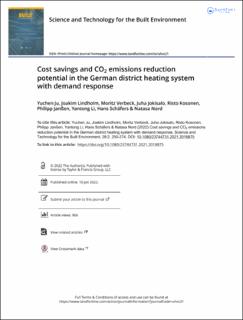| dc.contributor.author | Ju, Yuchen | |
| dc.contributor.author | Lindholm, Joakim | |
| dc.contributor.author | Verbeck, Moritz | |
| dc.contributor.author | Jokisalo, Juha | |
| dc.contributor.author | Kosonen, Risto | |
| dc.contributor.author | Janβen, Philipp | |
| dc.contributor.author | Li, Yantong | |
| dc.contributor.author | Schäfers, Hans | |
| dc.contributor.author | Nord, Natasa | |
| dc.date.accessioned | 2022-06-29T10:52:05Z | |
| dc.date.available | 2022-06-29T10:52:05Z | |
| dc.date.created | 2022-02-04T22:42:17Z | |
| dc.date.issued | 2021 | |
| dc.identifier.citation | Science and Technology for the Built Environment. 2021, 1-21. | en_US |
| dc.identifier.issn | 2374-4731 | |
| dc.identifier.uri | https://hdl.handle.net/11250/3001524 | |
| dc.description.abstract | Demand response (DR) has been an effective technique to maximize the proportion of renewable energies integrated into energy supply systems. This paper investigated the benefits of DR on three building types (apartment building, office building and cultural center) and analyzed DR impacts on operation, production costs and CO2 emissions of three district heating (DH) production scenarios. The results indicate that the application of DR cuts 2.8%–4.9% off heating costs for building owners based on different energy production scenarios and building types. From the perspective of DH producers, the large-scale application of DR reduces the total DH demand by 3.6% to 3.9%. It results in higher financial benefits, less CO2 emissions and optimization of energy production in all the analyzed scenarios. The maximum total energy generation cost-saving rate is 12.6%, and the CO2 emissions reduce at most 32.3% because of a more renewable production mix. Moreover, DR control increases the full load operation hours of the heat pump, leading to higher efficiency, and decreases the operation hours of the boilers, leading to less pollution. It indicates that the application of DR effectively decreases fossil fuel usage and improves the energy efficiency of DH systems. | en_US |
| dc.language.iso | eng | en_US |
| dc.publisher | Taylor & Francis | en_US |
| dc.rights | Attribution-NonCommercial-NoDerivatives 4.0 Internasjonal | * |
| dc.rights.uri | http://creativecommons.org/licenses/by-nc-nd/4.0/deed.no | * |
| dc.title | Cost savings and CO2 emissions reduction potential in the German district heating system with demand response | en_US |
| dc.type | Peer reviewed | en_US |
| dc.type | Journal article | en_US |
| dc.description.version | publishedVersion | en_US |
| dc.source.pagenumber | 1-21 | en_US |
| dc.source.journal | Science and Technology for the Built Environment | en_US |
| dc.identifier.doi | 10.1080/23744731.2021.2018875 | |
| dc.identifier.cristin | 1998042 | |
| dc.relation.project | Norges forskningsråd: 262707 | en_US |
| cristin.ispublished | true | |
| cristin.fulltext | preprint | |
| cristin.qualitycode | 1 | |

